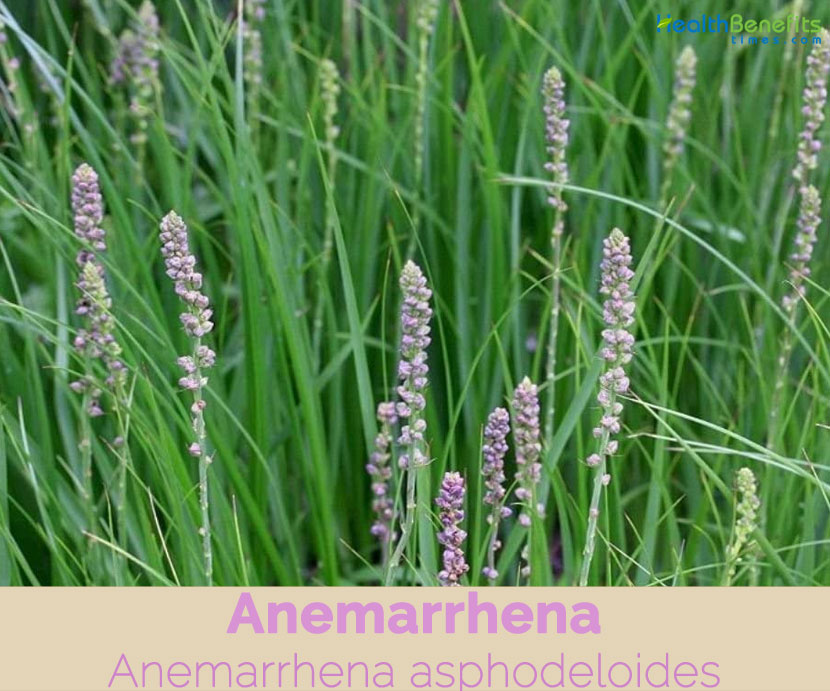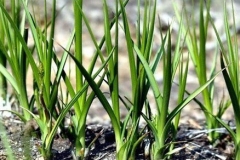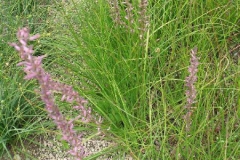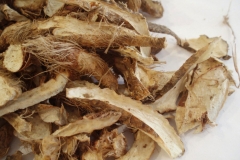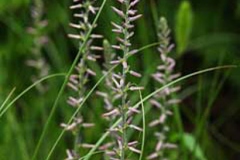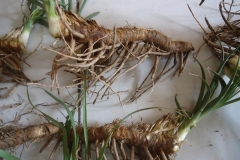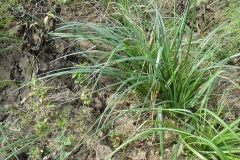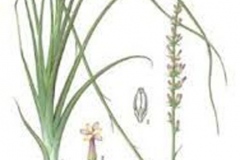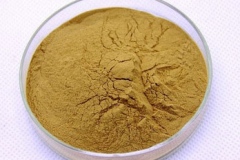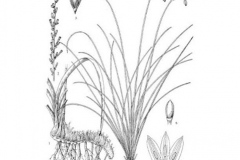Anemarrhena has been used as a staple of traditional Chinese medicine for centuries; its first recorded use dates back to 200 BC. Internally, it is used for a variety of disorders, including congestive fever, high fever, chronic bronchitis, excessive sweating, dry throat, cough, dizziness, lumbago and pneumonia. Externally, it is used as part of a mouth wash to treat oral ulcers. Extracts of the plant contain compounds called saponins — one of which, asphonin, can be used to effectively treat lower back pain.
Anemarrhena Facts
| Anemarrhena Quick Facts | |
|---|---|
| Name: | Anemarrhena |
| Scientific Name: | Anemarrhena asphodeloides |
| Origin | Japan, Korea, Mongolia and China |
| Shapes | Capsule 0.8-1.5 cm long and 0.3-0.6 cm wide including beaked apex |
| Taste | Bitter, sweet |
| Health benefits | Chronic bronchitis, Diabetes, Tuberculosis, Oliguria, High blood pressure, Ulcers of the mouth and/or bleeding gums, Urinary tract infections, Menopausal symptoms, Chemotherapy and radiation side effects |
| Name | Zhi Mu |
|---|---|
| Scientific Name | Anemarrhena asphodeloides |
| Native | Japan, Korea, Mongolia and China |
| Common Names | Common anemarrhena, Zhi mu |
| Name in Other Languages | Chinese: Zhi mu English: Common anemarrhena, Zhi mu French: Anemarrhena commune German: Muttergedenken Japanese: Hana suge (ハナスゲ) Korean: Jimo Pinyin: Zhi mu Persian: آنمارهنا اسفدلیدس Russian: Anemarena asfodeleobraznaya (анемарена асфоделеобразная) Spanish: Anemarrena Swedish: Axlilja |
| Plant Growth Habit | Small evergreen, ornamental, perennial, decorative plant |
| Growing Climates | Mountain woodlands, exposed slopes, hills, scrub, grassy slopes, steppes, sunny and sandy hillsides and also cultivated near sea level |
| Soil | Requires a rich moist neutral to acid soil that is rich in organic matter, in a position in partial or dappled shade. Plants are tolerant of strong winds |
| Plant Size | About half a meter tall |
| Rhizomes | Large, hard, and round with pale-yellowish color inside |
| Leaf | Simple and up to 60 cm long but just 0.15 to 1 cm wide |
| Flowering season | August to September |
| Flower | Pink, violet or whitish, funnel shaped and stand in spikes |
| Fruit Shape & Size | Capsule 0.8-1.5 cm long and 0.3-0.6 cm wide including beaked apex, prominently 6-angled. |
| Seed | Black, narrowly oblong-elliptic, slightly curved, 7-12 mm long and 2.5–3 mm wide |
| Plant Parts Used | Root, Rhizome |
| Available Forms | Whole herb, capsules, and teas |
| Taste | Bitter, sweet |
| Health Benefits |
|
Plant Description
Anemarrhena is a small evergreen, ornamental, perennial, decorative plant that normally grows about half a meter tall. The plant is found growing in mountain woodlands, exposed slopes, hills, scrub, grassy slopes, steppes, sunny and sandy hillsides and also cultivated near sea level. The plant requires a rich moist neutral to acid soil that is rich in organic matter, in a position in partial or dappled shade. Plants are tolerant of strong winds. Rhizomes are large, hard, and round with pale-yellowish color inside and are best for medicinal use. Rhizomes (roots) and the stems of the plant are the medicinal parts of the plant. They are often dried for use in decoctions. Leaves are simple and up to 60 cm long but just 0.15 to 1 cm wide.
Flowers and Fruits
Flowering scape is 35 – 100 cm tall. Flowers are pink, violet or whitish, six-petaled funnel shaped and stand in spikes. The fragrant flowers open in the evening. Flowering normally takes place from August to September.
Fertile flowers are followed by 0.8–1.5 cm long and 0.3–0.6 cm wide capsules including beaked apex and are prominently 6-angled. Seeds are black, narrowly oblong-elliptic, slightly curved, 7—12 mm long and 2.5–3 mm wide.
Health benefits of Anemarrhena
Listed below are some of the popular health benefits of anemarrhena
1. Chronic bronchitis
Several researches have shown that anemarrhena can effectively eradicate infections caused by Staphylococcus aureus, the bacterial strain that often causes lung infections. Anemarrhena has been effectively used to treat bronchitis as well as worsening symptoms of chronic bronchitis such as chronic coughing.
2. Diabetes
Chinese herbalists believe that yin deficiency is the fundamental cause of diabetes; they often use anemarrhena to treat this disease. In fact, there is scientific proof to support its use in the treatment of diabetes. Animal research show that anemarrhena consists of two pharmacologic agents, mangiferin and mangiferin-7-0-beta glucoside, which seem to increase the effectiveness of insulin and can lower blood glucose levels. Anemarrhena has the greatest effect in mild to moderate diabetic conditions. However, it does not affect glucose levels in non-diabetic conditions. Anemarrhena may be combined with Shi Gao (Gypsum) for additional hypoglycemic effects.
3. Tuberculosis
Anemarrhena is used to treat tuberculosis. However, research does not support its use. When given as 2.5% powder, anemarrhena may slow down disease progression, but overall it does not reduce death rates. At higher dosage (5% powder), anemarrhena appears to be toxic. More mice treated with anemarrhena died than in the control group. Therefore, even though the herb can effectively reduce the low-grade fever associated with tuberculosis, it is a poor substitute for conventional antibiotics, which can cure the disease and prevent death.
4. Oliguria
Anemarrhena offers moisture to dry internal organs. Thus, it is often used as diuretic to improve kidney function.
5. High blood pressure
Anemarrhena is often used in combination with phellodendron and rehmannia to treat high blood pressure in patients with symptoms of Liver-fire deficiency (dizziness, headache, ringing in the ears, back pain, insomnia, palpitations, dry eyes, and night sweat). Recent studies in laboratory animals confirm that this herb is effective in lowering blood pressure.
6. Ulcers of the mouth and/or bleeding gums
Anemarrhena can restore moisture in these oral conditions that exhibit excessive dryness and inflammation.
7. Urinary tract infections
Anemarrhena has been used to treat cystitis, an infection of the bladder. Research has shown that it is effective against Escherichia coli, which commonly causes cystitis in women. Thus, it may be effective against urinary tract infections caused by this bacterial strain.
8. Menopausal symptoms
Anemarrhena is quite effective in treating menopausal symptoms such as insomnia, hot flashes, and irregular periods.
9. Chemotherapy and radiation side effects
Anemarrhena is often effective in relieving severe adverse reactions associated with conventional chemotherapy and radiation treatments in cancer patients. According to traditional Chinese medicine, x rays used in radiation treatment and drugs used in chemotherapy are considered “heat toxins.” These agents are very toxic so that they can kill tumor cells. But they are also toxic to the body, causing excessive build-up of heat inside the Lungs and damaging the Kidneys.
10. Other infections
There is little information available regarding the use of anemarrhena in other types of infections. However, laboratory studies show that anemarrhena has antibacterial activity against Salmonella typhi and Vibrio cholera, the bacteria that cause salmonella food poisoning and cholera, two common infections of the bowels. Research also shows that anemarrhena may also be effective against fungal infections.
Traditional uses and benefits of Anemarrhena
- Rhizome is anti-fungal, antiseptic, bitter, diuretic, expectorant, febrifuge, hypo-glycaemic, laxative, lenitive, sedative and tonic.
- It has an antibacterial action, preventing the growth of Bacillus dysenteriae, B. typhi, B. paratyphi, Proteus and Pseudomonas.
- It can be taken internally in the treatment of high fevers in infectious diseases, TB, chronic bronchitis, diabetes and urinary problems.
- Externally, it is used as a mouthwash in the treatment of ulcers.
- It is used medicinally to remove heat, quench fire, support the production of body fluid, and alleviate dryness syndrome.
- In Korea, mainland China, and Japan, the rhizomes have been traditionally used for their anodyne, anti-diabetic, anti-inflammatory, antipyretic, diuretic, antidepressant, antiplatelet aggregator, and sedative properties.
- In traditional Chinese medicine, the rhizomes are also used for the treatment of lung disease.
- Anemarrhena has been used to relieve symptoms such as coughing, ulcers of the mouth, kidney dysfunction, urinary tract infection, insomnia, restlessness, genital herpes, and sterility.
- Extract can also prevent the growth of some bacteria, for example Pseudomonas.
- It is also used by women in the menopause that have hot flashes.
- Zhi mu is used in Chinese herbal medicine for excess heat, fever, night sweats, and coughs.
- It is used to treat canker sores, mostly in combination with rehmannia.
Ayurvedic health benefits of Anemarrhena
- Cough: Prepare a decoction of Skullcap flower and Anemarrhena rhizome. Take it twice a day.
- Night Sweat: Take equal quantity of Rehmannia and Anemarrhena. Grind them together. Have 1/4 teaspoon with lukewarm water thrice a day. (Caution: Don’t take fried food.)
- Night Sweat: Take equal quantity of Rehmannia, Cornus Florida, White Peony, Yam Rhizome, Hoelen, Water Plantain, Anemarrhena and Phellodendron Amurense. Powder all ingredients together. Have one teaspoon with milk at night.
- Japanese Encephalitis: Take 20 gram Anemarrhena, 40 gram Earthworm, 50 gram Woad, 40 gram Honeysuckle, 40 gram Scrophularia Ningpoensis and 100 gram Gypsum. Make a decoction with them. Drink 10 ml of it twice a day.
- Reproductive Problems of Males: Ginseng Korean, Astragalus, Dong Quai, Rehmannia, Cuscuta Chinensis, Goji Berry, Fennel, Zanthoxylum Piperitum, Morinda Officinalis, Cornus Officinalis, Polyporus Umbellatus, Psoralea, Achyranthes Aspera, Yam Rhizome, Horny Goat Weed, Eucommia, Cinnamon, Paeonia Suffruticosa, Raspberry, Chinese Knotweed, Anemarrhena , Atractylodes Macrocephala, Water Plantain, Senega, White Peony, Anemone Chinensis and Honey, in conjunction are beneficial for Reproductive Problems of Males and act as a powerful kidney tonic. You may buy the formula, containing the above mentioned Herbs. Capsule form is readily available. Consume 1 capsule 3 times a day.
Preparations
The usual dosage of anemarrhena is 6–12 g per day. It is accessible as a single ingredient or in combinations in the following forms:
- Powder or pills: Should be taken with warm water on an empty stomach.
- Decoction: A method often used in traditional Chinese medicine to make an herbal preparation at home. Herbs, usually in combination, are simply boiled down to a concentrated broth or tea to be taken internally.
Other Facts
- Root consists of about 6% saponin.
- Saponin makes an excellent soap, having a gentle cleansing effect on the skin and clothes without removing the natural body oils from the skin.
- To extract the saponin it is usually sufficient to cut the root into thin slices and then gently simmer in water.
- The fragrant flowers open in the evening.
Precautions
- It should not be given to patients with diarrhea and should be administered with caution since when taken in excess it can cause a sudden drop in blood pressure.
- Avoid use in patients with known allergy or hypersensitivity reactions to A. asphodeloides or its constituents.
- Avoid its use in case of spleen and stomach deficiency due to cold.
- Anemarrhena, when administered intravenously at only moderate dosage, can cause breathing difficulty and a decrease in blood pressure.
- High dosages supposedly can cause a severe drop in blood pressure, respiratory arrest, and even death.
References:
https://pfaf.org/user/Plant.aspx?LatinName=Anemarrhena+asphodeloides
https://www.drugs.com/npp/zhi-mu.html
http://morsec.eeb.uconn.edu/201900046.html
https://npgsweb.ars-grin.gov/gringlobal/taxonomydetail.aspx?id=3369
http://temperate.theferns.info/plant/Anemarrhena+asphodeloides
http://www.theplantlist.org/tpl1.1/record/kew-299155
https://www.encyclopedia.com/medicine/encyclopedias-almanacs-transcripts-and-maps/anemarrhena
http://www.efloras.org/florataxon.aspx?flora_id=2&taxon_id=200027556
https://en.wikipedia.org/wiki/Anemarrhena


